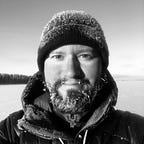Embrace the Uncanny
A gaping disparity has appeared between what Amitav Ghosh in The Great Derangement calls ‘bourgeois belief in the regularity of the world’ and the emerging observations of intrusive, non-human forces therein.
That sounds very fancy and all, but I see it everywhere. In fact, it has become impossible not to see the new, uncanny weather perturbing the social realities of people not just in the Global South, but also in the Western and Nordic parts of the world.
I could list all the weather events from past twelve months which were record breaking, odd or out of place. I’d begin from Helsinki getting flooded, being under two low pressures which came over Finland from abnormal angles causing blackouts and forestry losses. These were documented events, where data from the Finnish Meteorological Institution clearly showed a deviation from the normal.
Even these events were not uncanny enough, as I quickly found out after I moved to Bodø for my master’s studies in climate change and politics. There has literally been no winter here if you look at the average temperatures of past months. Not a single time have we been consistently below 0°C for more than a couple of days.
Now, how did I come to notice the unusual weather like this? Might I have been a bit sensitive or biased to heightened sense of awareness because I am deeply interested in the phenomenon called human-caused climate change?
I don’t think so. These are measured anomalies deviating from carefully constructed, reliable long-term sets of weather observations. But alright, since we are in an alt-factual landscape in society, such data might cause the most rigorous of sceptics to question if all of this is even happening.
In my past life I was studying law which taught me to be very methodological in sourcing and handling of information. In that line of work, you fail immediately when facts do not stack up or a statement cannot be verified in obedience to strict legal hierarchy of norms.
I now understand that such method might not work in other areas of society, such as in politics, where the accumulation of votes relies on stroking various feelings in the general population.
Illustration above seems fairly benign if you do not possess expert knowledge of high-end climate change impacts caused by accelerating human-caused accumulation of greenhouse gases in the atmosphere which are unfortunately amplified by feedbacks in the climate system.
If one keeps up with the most fresh climate science, one will know that most of what that picture contains in the left is already underway. Scientific debate now is about how fast, how disruptive and how irreversible are these changes going to be.
From physical science and techno-economic view points, combined analysis of both images above implies a likely scenario in which, collectively, the stabilisation of the climate somewhere close to a global 2°C average will become impossible.
That is as uncanny as any kind of finding humans have ever produced can be. But it is still very clinical. Almost as if some how some one could come up with a technology which sucks that nasty CO2 out of the atmosphere and all shall be well.
In fact, it seems that such technology, which does not currently exist, is assumed for a decent chance to stabilise global average temperatures ‘well below 2°C’ as it is boldly written in the Paris Agreement.
No one can accurately predict what the future will look like, but usually the present gan give some guidance. Let’s look at current politics. With the United States experiencing something of a political coup at the highest levels of government, its largest non-violent civil protests at least after the Vietnam War, the United Kingdom exiting the European Union and that organisation it self holding on to what is called the liberal world order, one must observe that uncanny events and abnormalities are not limited to what is happening with climate change as a physical phenomenon.
Yet, if you look at daily life in any little town or city in the Nordics, people carry on their business, students study and even party some times. Skiers go skiing, cars are being bought, airplanes fly over head and so on.
Almost as if nothing I just described is happening at all.
On a more practical note, I think it is much more useful to carry on with what ever one is doing, if it is broadly in line with the ambition set out in the Paris Agreement rather than obsess over the big picture too much.
